Services on Demand
Article
Indicators
Related links
-
 Cited by Google
Cited by Google -
 Similars in Google
Similars in Google
Share
Journal of the Southern African Institute of Mining and Metallurgy
On-line version ISSN 2411-9717
Print version ISSN 2225-6253
J. S. Afr. Inst. Min. Metall. vol.115 n.12 Johannesburg Dec. 2015
http://dx.doi.org/10.17159/2411-9717/2015/v115n12a10
PAPERS - CHEMICAL ENGINEERING & METALLURGY AT WITS
Titanium carbide-silicon nitride reactions at high temperature
N. Can; R. Hurman Eric
School of Chemical and Metallurgical Engineering, University of the Witwatersrand, Johannesburg
SYNOPSIS
The kinetics and mechanism of the chemical interaction between silicon nitride and titanium carbide were investigated using thermogravimetric analysis (TGA). The samples were reacted isothermally at temperatures between 1600°C and 1700°C under nitrogen and argon atmospheres. The extent and rate of reaction increased with increasing temperature under both atmospheres; however, both the extent and rate were higher under argon. Silicon nitride, in the presence of titanium carbide, was thermally stable under nitrogen and the reactions were confined to Si3N4/TiC and TiC/N2 interfaces. Under argon atmosphere silicon nitride dissociated completely to liquid silicon and nitrogen gas within about four hours of reaction time, depending on temperature, and a different reaction mechanism prevailed. The kinetics of interaction between silicon nitride and titanium carbide under nitrogen atmosphere was found to be controlled by the rate of diffusion of nitrogen into the titanium carbide/carbonitride phase. Under argon atmosphere the rate was found to be controlled by the rate of dissociation of silicon nitride. For both cases the mechanisms of reactions were determined in detail and then modelled.
Keywords: silicon nitride, composite materials, densification, titanium carbide.
Introduction
Silicon nitride is among the new-high technology materials. It is usually synthesized by reacting silicon with nitrogen. The product is a ceramic powder, and with sintering and densification the structural ceramic is obtained. Resistance to thermal shock, high-temperature creep, erosion, and corrosion make silicon nitride attractive for engine components and cutting tools (Gnesin et al., 1978; Zilberstein and Buljan, 1984).
The main problem in production of silicon nitride is in the sintering and densification. Silicon nitride is very difficult to sinter to high densities (Jack, 1976). Many additives have been used as sintering aids, many of which are detrimental to the unique properties of silicon nitride, especially for high-temperature applications (Smith and Quackenbush, 1980; Govila, 1985; Kriz, 1983). Therefore, instead of monolithic silicon nitride, composite materials based on silicon nitride have been investigated. In that respect, mixing silicon nitride powder with titanium carbide powder will not only assist densification but also enhance the properties further by combining the benefits of carbides and nitrides (Mah, Mendiratta, and Lipsitt, 1981). Si3N4-TiC composite materials are suitable for wear and metal-cutting tool applications (Baldoni and Buljan, 1988).
Successful composite development requires a detailed understanding of the chemical interactions between components of the composite materials. Chemical reactions between the matrix phase and dispersed particles during the sintering stage may alter the properties relevant to performance in severe environments such as high-speed metal removal (Buljan and Zilberstein, 1987).
However, little is known about the fundamental mechanistic of the reactions between silicon nitride and titanium carbide that assist property improvement. Thus, the purpose of this paper is to report on the investigation related primarily to the mechanism of the reactions between Si3N4 and TiC at temperatures between 1600°C and 1700°C.
Experimental procedure
The reactions between silicon nitride and titanium carbide in the powder compact under N2 and Ar atmospheres at temperatures of 1600°C, 1650°C, and 1700°C were investigated isothermally by thermogravimetric analysis (TGA).
Very high purity Si3N4 powder with less than 10 ppm Fe and 2 ppm Ca+Mg as impurities, 1 μm average size, was mixed with very high purity TiC powder with 6 ppm Fe and 2 ppm Ca as impurities (both supplied by Aldrich Chemical Company, Wisconsin, USA) under methanol with an agate mortar and pestle. The very low impurity levels were not considered to have any effect on the reactions. The average particle sizes of the TiC powders were 3, 5, 50, and 100 μm. After mixing Si3N4 and TiC powders at certain volume per cent ratios (20, 30, and 40 vol% TiC, balance Si3N4), the powder mixtures were pressed into disc shapes. The green density of the compact was kept constant at approximately 60% of the ideal density based on the linear rule of mixtures by applying constant uniaxial pressure of 5 t. The approximate dimensions of the pellets were 10 mm diameter and 5 mm thickness. The kinetics of the reactions between Si3N4and TiC were investigated by measuring the weight change upon reactions taking place in the powder compact at constant temperatures and different time intervals using TGA.
The TGA set-up consisted of gas cleaning and regulating facilities, a vertical-tube furnace with six lanthanum-chromite heating elements parallel to the recrystallized alumina work tube axis, and a balance positioned at the bottom of the furnace assembly and linked to a computer for continuous weight change measurements. Although this set-up was suitable for continuous weight change measurements, the drift of the balance caused some experimental error. Therefore, in addition to continuous weight loss measurements, intermittent weight change measurements were carried out by an outside balance.
Sample pellets were charged into the furnace and reacted under flowing N2 or Ar gas streams at a flow rate of 800 ml/min at atmospheric pressure. Experiments were carried out at the temperatures mentioned earlier. Samples were then lowered to the cool end of the furnace tube and quenched by the incoming stream of the gas.
The maximum reaction time for each set of experiments was selected in such a way that after the longest holding time there was no weight change; in other words the curve of percentage reaction completed versus reaction time levelled off. This maximum holding time for any set of experiments under nitrogen atmosphere was 16 hours. Nevertheless, an identical experimental run for each set of experiments was performed up to 36 hours to check if weight changes would occur. All the experiments were performed twice, and if more than 10% difference in mass loses was found the experimental system was checked for leaks by additional carbon blank runs. Normally, carbon blank runs were done after every 15 experiments for a period of two hours to ensure a sound operating system.
Results and discussion
The actual reactions between Si3N4and TiC are complicated. Therefore, preliminary thermodynamic calculations were carried out in the Si-Ti-C-N system with respect to pure species in standard state to understand the chemical interactions in the composite during sintering. Table I shows possible reaction products after reaction of Si3N4and TiC, including unreacted species.

Standard free energy changes of possible reactions were studied at temperatures between 1300°C and 2000°C by using a thermodynamic program, Thermo V2.03 (Mintek, South Africa) based on a free energy minimization technique. Only two reactions have been considered due to lower standard free energy change values: these are:

Poster (1988) has proposed that TiC and TiN can form TiC1-χΝχsolid solution at high temperatures by the following reaction:

Since the change in lattice parameter of the solid solution obeys Vegard's law (Goldschmidt, 1967) TiC1-xNx solid solution was assumed to behave ideally in this investigation. The standard free energy of formation of TiC1-xNx ideal solid solution may be calculated by the following equation:

When the possibility of formation of TiC1-xNx solid solution is considered, Equations [1] and [2] become

The stability regions of Equations [1], [2], [5], and [6] are illustrated in Figure 1. Clearly, reactions [5] and [6] are thermodynamically more stable than reactions [1] and [2] for the temperature range of the study. Therefore, formation of titanium carbonitride is thermodynamically more favourable than formation of TiN as a reaction product. At temperatures between 1600°C and 1700°C the difference in calculated standard free energy change of reactions [5] and [6] is very small, thus the kinetics will play a major role. However, if N2 pressure is increased in the system (such as high-temperature gas pressure sintering), reaction [5] will be the main reaction in the system.

Kinetic analyses in the Si3N4-TiC system were carried out in N2 and Ar atmospheres in the temperature range of 1600°C and 1700°C and the weight losses were observed. Therefore, it was assumed that Equation [6] is the dominant reaction in the system. Observed weight losses were converted into the per cent reaction completed values as follows:

The maximum possible weight loss in Equation [7] is obtained from the stoichiometry of reaction [6] assuming a maximum possible attainable value of 1.0 for the factor 'x'. Then the maximum possible weight loss will be equal to 1/6(WTiC)(MN2/MTiC), where WTiC is the mass of TiC in the sample powder compact, and MN2 and MTiC are the molecular masses of the N2 gas (which leaves the sample and causes weight loss) and TiC respectively.
Reaction under nitrogen atmosphere
According to the kinetic results obtained, the most significant factor influencing the reaction rate and extent of reaction under nitrogen atmosphere was found to be temperature, with about five times increase between 1600°C and 1700°C as illustrated in Figure 2. The effect of temperature increase from 1600C° to 1650°C on the reaction rate and extent of reaction is not as significant as temperature increase from 1650°C to 1700°C. This can be attributed to a decrease in the thermal stability of silicon nitride because the equilibrium nitrogen pressure above silicon nitride is one atmosphere at 1900°C; its normal dissociation temperature. Therefore, partial dissociation of silicon nitride significantly increases the reaction rate.

Percentage reaction completed versus time curves at temperatures of 1600°C and 1650°C showed a marked slowdown in the reaction rate after approximately one hour of reaction time (based on slopes of the curves in Figure 2). This change in the rate of the reaction is most probably due to the nature of the solid-solid reactions where reaction products form a diffusion barrier (Zilberstein and Buljan, 1984). However, for reactions at 1700°C, formation of this diffusion barrier takes longer, and the reason for this may be the presence of liquid silicon due to partial dissociation of silicon nitride as found in this study. The presence of liquid silicon (even if it exists temporarily under nitrogen atmosphere) enhances reactions by increasing the rate of diffusional mass transfer of nitrogen and carbon through the liquid phase in comparison to their diffusion in tightly bound solid phases such as silicon carbide and titanium carbonitride.
The kinetic curves for three different volume percentages of TiC in the initial pellet reacted under similar conditions are given in Figure 3. As can be seen, the increase in volume concentration of TiC increases the reaction rate and the extent of reaction. Since the amount of Si3N4was always higher than the stoichiometric amount dictated by Equations [5] and [6], saturation of the reaction with increasing TiC content is not expected. An increase in TiC content in the prepared samples increases the surface area where there is direct contact between Si3N4and TiC particles, and consequently increases the reaction rate. At 1700°C the extent of reaction increases three times when the volume concentration of TiC increases from 20 to 40 vol%. Therefore, concentration of TiC constitutes the second largest effect (after temperature) on the reaction kinetics between Si3N4and TiC. This indicates that reactions between Si3N4and TiC occur on the contact points or interfaces, which is common for solid-solid interactions.

In order to elucidate the effect of particle size on the reaction kinetics, the particle size of the silicon nitride was kept constant and titanium carbide particle sizes were increased from 5 μm to 100 μm. The results are shown in Figure 4. The effect of increasing particle size of TiC on the rate and extent of reaction was not very pronounced during the first 30 minutes, after which there is a large decrease in reaction rate and extent when the TiC particle size is increased to between 50 and 100 μm.

Changing the particle size of TiC from 50 μm to 5 μm doubled the extent of reaction. It seems that particle size is less critical for the extent and rate of the reaction than temperature and volume concentration of TiC.
Figure 5 compares the XRD patterns that were obtained from 30 vol% TiC reacted under N2atmosphere at 1600°C for different retention times. It is clear that the primary peaks of silicon nitride exist even after twelve hours of reaction time, and silicon carbide formation becomes noticeable after four hours of reaction. The position of the titanium carbide peak on the XRD pattern has been marked, as shown in Figure 5, and as the retention time increases, titanium carbonitride formation is reflected by the gradual shift from the indicated titanium carbide peak position to higher 2Θ° values, toward the hypothetical titanium carbonitride peak. The shape (broadness) of the titanium carbide peaks may indicate the existence of a wide range of composition within the reacted powder mixture. Since the starting powder contains a fairly narrow size range of titanium carbide particles, the peak broadening and shift can only be attributed to the formation of titanium carbonitrides. The maximum 'x' value in TiC1-xNx was found to be 0.67 under nitrogen atmosphere. The 'x' value was derived as follows. Titanium carbide and titanium nitride have simple cubic crystal structures that are identical to the NaCl structure. Therefore, the TiC1-xNx peaks in the XRD patterns lie between the positions of the titanium carbide and titanium nitride peaks. The shift of TiC1-xNx peaks from (2 0 0) and (1 1 1) planes was measured by taking into account the angular distance between titanium carbide and titanium nitride peaks from the same crystallographic planes. After calculation of each shift from its respective plane, the 'x' value that represents titanium carbonitride composition was deduced by taking the average of those two values. The 'x' values were also checked by SEM point analysis. The error in the calculations and measurement of the 'x' was approximately 4 per cent.

Reaction under argon atmosphere
The nature of the interactions between Si3N4 and TiC changed drastically when the experiments were carried out under Ar atmosphere. Si3N4 is not stable under Ar atmosphere in the presence of TiC and dissociates into liquid silicon and nitrogen. Therefore, the later stages of the interactions in the system involve to a large extent interactions with the liquid phase, which is rich in silicon.
The effect of temperature on the extent and the rate of reaction between silicon nitride and titanium carbide is illustrated in Figure 6. As in the case of reactions under nitrogen atmosphere, increasing temperature increases the extent and the rate of the reaction. At 1600°C and 1650°C the extent of reaction increases gradually, whereas for samples reacted at 1700°C there is a sharp increase in the rate and extent of reaction initially (0 to 120 minutes of reaction time). This can be attributed to the decreasing stability of silicon nitride with increasing temperature and, consequently an increase in the liquid silicon-rich phase. The extent of reaction at 1700°C reaches almost 100 per cent after six hours of reaction time, indicating that almost all of the silicon nitride in the powder compact dissociated, whereas it takes eight to ten hours to reach 100 per cent at 1650°C and 1600°C respectively.

The effect of changing TiC concentration on the extent and rate of the interactions under Ar atmosphere is depicted in Figure 7. During the first hour, the reaction between Si3N4 and TiC under Ar atmosphere at 1700°C is not affected by changing TiC concentration. In the later stages of the reaction, however, decreasing TiC concentration increases the percentage reaction completed. Since the reaction rate depends predominantly on the dissociation of Si3N4 under Ar atmosphere, this dissociation reaction takes place at a higher rate (see Figure 8) in the earlier stages of the interactions and obscures the effect of TiC concentration. The silicon-rich phase is produced as a dissociation product of Si3N4. This phase can also contain some dissolved Ti, C, and N. During the later stages, the interactions occur by reaction of the remaining TiC with the Si-rich phase. Decreasing TiC concentration seems to increase the extent of chemical reactions with this intermediate phase. However, differences in percentage reaction completed are small.


Figure 8 compares the XRD patterns that were obtained from 30 vol% TiC reacted under Ar atmosphere at 1650°C for different retention times. The peaks representing silicon nitride phase in the XRD pattern disappeared after four hours of reaction under Ar atmosphere, i.e. almost all of the Si3N4dissociated within four hours. The increase in the amount of SiC, which may be noted from the increasing intensity of the (111) plane of the β-SiC diffraction peak, was much less in N2 atmosphere than in Ar atmosphere. This also confirms that silicon nitride dissociates much faster in an Ar atmosphere and reaction between liquid silicon and TiC occurs at a much higher rate than the reactions with Si3N4and TiC (both reactions produce SiC). The sharp shift in the diffraction peak of titanium carbide is also noticeable in Figure 8. The maximum 'x' value of the titanium carbonitride phase under argon atmosphere was calculated as 0.78.
Mechanism of the reaction between Si3N4and TiC
Considering the results of the preliminary thermodynamic, TGA, and X-ray diffraction analyses, a unique reaction mechanism for the system Si3N4-TiC can be proposed. The nature of the reaction in the Si3N4-TiC system depends strongly on the partial pressure of nitrogen gas in the system, thus two reaction mechanisms in the ceramic composite during sintering stage are proposed.
The situation just before the reaction between Si3N4and TiC in in a N2atmosphere is shown in Figure 9. TiC particles are irregular in shape with average particle size of 3 μm, and Si3N4 particles are round with 1 μm average particle size. Nitrogen gas occupies the voids between the particles.
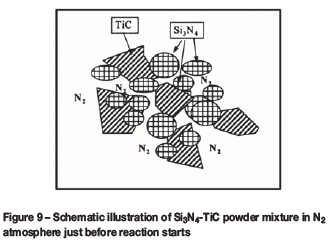
The initial stage of the reactions in N2atmosphere (Figure 10) commences by the direct contact of Si3N4and TiC particles as well as N2reaction with TiC particles at the gas/TiC interface. Direct reaction between Si3N4 and TiC takes place by Equation [6], in which nitrogen atoms diffuse from the Si3N4matrix to the TiC matrix to form the thermodynamically stable TiC1-xNxphase and rejected carbon atoms from the TiC matrix react with Si3N4to form SiC. Similarly, at the gas/TiC interface, nitrogen atoms from the gas phase diffuse through the TiC matrix and form TiC1-xNx. Carbon atoms from the formation of the TiC1-xNxphase diffuse through the gas/TiC interface or Si3N4/TiC reaction interface to the surface of the titanium carbonitride phase and are deposited there until they eventually react further to form SiC.
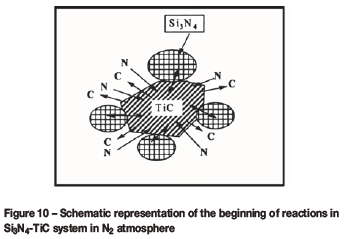
As the reaction proceeds further (Figure 11) in N2 atmosphere, reaction product layers form between the reaction interfaces. The SiC phase forms between the Si3N4 and TiC1-xNxphases and grows by solid state diffusion of carbon atoms through SiC reaction product layer to the SiC/Si3N4reaction interface. Some of the nitrogen gas, either from direct reaction of TiC and Si3N4or reaction of carbon and Si3N4, leaves the system and causes weight loss. The reaction interface between TiC1-xNx /TiC penetrates toward the centre of the particle to consume unreacted TiC matrix by simultaneous diffusion of carbon and nitrogen atoms.
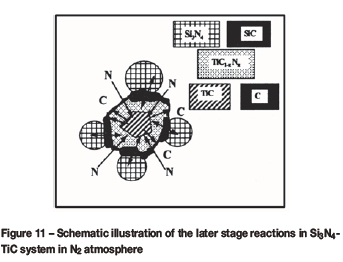
Since Si3N4 is not thermodynamically stable in an Ar atmosphere within the experimental temperature range, it will dissociate into Si (l) and N2 (g). Therefore, Equation [6] will be the main reaction in the Si3N4 -TiC system during sintering in Ar atmosphere. Similar to the reactions in N2atmosphere, interaction between Si3N4 and TiC starts at the direct contact surfaces between the particles, in which nitrogen atoms diffuse to the TiC matrix to form TiC1-xNx and carbon atoms from this reaction simultaneously diffuse through the reaction product layers and react with Si3N4 to form SiC (Figure 12). Reactions in the Si3N4 -TiC system enhance the dissociation of Si3N4 and thus liquid silicon and N2 gas cover the TiC particles.
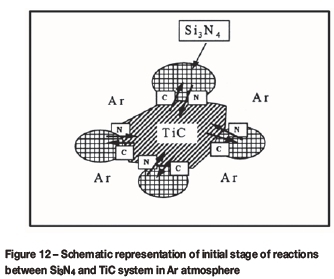
In the later stages of the reaction (Figure 13), silicon nitride particles become irregular due to dissociation. The partial pressure of N2gas within the powder compact is equal to the equilibrium partial pressure of N2gas above Si3N4 particles. Reactions in the system proceed similar to reactions in N2atmosphere through diffusion of nitrogen atoms to the reaction interface between TiC1-xNx and unreacted TiC, and carbon atoms that are rejected from TiC diffuse through the reaction product layers to the Si (l)/SiC reaction interface or undissociated Si3N4/SiC reaction interface.
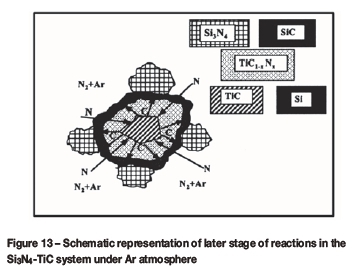
Conclusions
High-temperature interactions between Si3N4 and TiC in N2and in Ar atmosphere are governed mainly by the reaction:

The reaction products consist of β-SiC and TiC1-xNx in N2 atmosphere, as well as liquid silicon in Ar atmosphere. Si3N4is not stable in Ar atmosphere and completely dissociates into liquid silicon and nitrogen, and interactions between Si3N4and TiC increase the dissociation rate of Si3N4. After the reactions in Ar atmosphere, the matrix phase consists of liquid silicon and SiC and all the TiC particles are converted into TiC1-xNx by reaction with nitrogen. However, in N2atmosphere, even after prolonged reaction periods, Si3N4is the stable phase in the system and forms the matrix. The reaction rate and extent in Ar atmosphere are considerably higher than in N2 atmosphere because of the involvement of liquid silicon as an intermediate phase. The overall reaction between Si3N4and TiC involves a direct chemical reaction at the reaction interface, and when the reaction product layers cover the particles, reactions are controlled by the diffusion of carbon and nitrogen atoms though the reaction product layers.
The kinetics of interactions between silicon nitride and titanium carbide was analysed in detail, resulting in a complex and lengthy mathematical model involving contracting-volume model equations as well as non-steady-state diffusion equations. The details of the kinetic modelling are beyond the scope and subject of this paper. However, it can be mentioned that the effective nitrogen diffusion coefficient was found to change between 2.28x10-13 and 6.29x10-14cm2/s. The apparent activation energy for reactions under nitrogen atmosphere was 495.5 kJ/mol. The specific rate constant for reactions under argon atmosphere was calculated to change from 1.45x10-7to 8.96x10-8cm/s. The apparent activation energy was 432.0 kJ/mol.
References
Baldoni, J.G. and Buljan, S.T. 1988. Ceramics for machining. Ceramic Bulletin, vol. 67, no. 2. pp. 381-387. [ Links ]
Buljan, S.T. and Zilberstein, G. 1987. Microstructure development in Si3N4 based composites. Material Research Society Symposium, vol. 78. pp. 273-281. [ Links ]
Duwez, P. and Odell, F. 1950. Phase relationships in the binary systems of nitrides, carbides of zirconium, columbium, titanium, and vanadium. Journal of the Electrochemical Society, vol. 97, no. 10. pp. 299-304. [ Links ]
Gnesin, G.G., Osipova, Yaroshenko, V.P., and Rontal, C. 1978. Optimization of the properties of a tool material based on silicon nitride. Journal of Metallurgical Ceramics, vol. 17, no. 2. pp. 124-127. [ Links ]
Goldschmidt, H.J. 1967. Interstitial Alloys. Butterworth, London. [ Links ]
Govila, R.K. 1985. Strength characterization of yttria-doped sintered silicon nitride. Journal of Material Science, vol. 20. pp. 4345-4353. [ Links ]
Jack, K.H. 1976. Sialons and related nitrogen ceramics. Journal of Material Science, vol. 11. pp. 1135-1158. [ Links ]
Kriz, K. 1983. The fracture behavior of hot-pressed silicon nitride between room temperature and 1400°C. Progress in Nitrogen Ceramics. pp. 523-28. [ Links ]
Mah, T., Mendiratta, M.G., and Lipsitt, H.A. 1981. Fracture toughness and strength of Si3N4-TiC composite. Ceramic Bulletin, vol. 60, no. 11. pp. 1229-1240. [ Links ]
Poster, H. 1988. Titanium-carbonitride-based hard alloys for cutting tools. Material Science Engineering, vol. A105/106. pp. 401-409. [ Links ]
Smith, J.T. and Quackenbush, C.L. 1980. Phase effects in Si3N4 containing Y203 or Ceo2. Bulletin of the American Ceramic Society, vol. 59, no. 5. pp. 529-537. [ Links ]
Zilberstein, G. and Buljan, S.T. 1984. Characterization of matrix reactions in Si3N4-TiC composites. Advances in Materials Characterization II, Material Science Research. New York College of Ceramics, Alfred, New York. Vol. 17. pp. 389-401. [ Links ]
Paper received May 2015
Revised paper received Oct. 2015.














